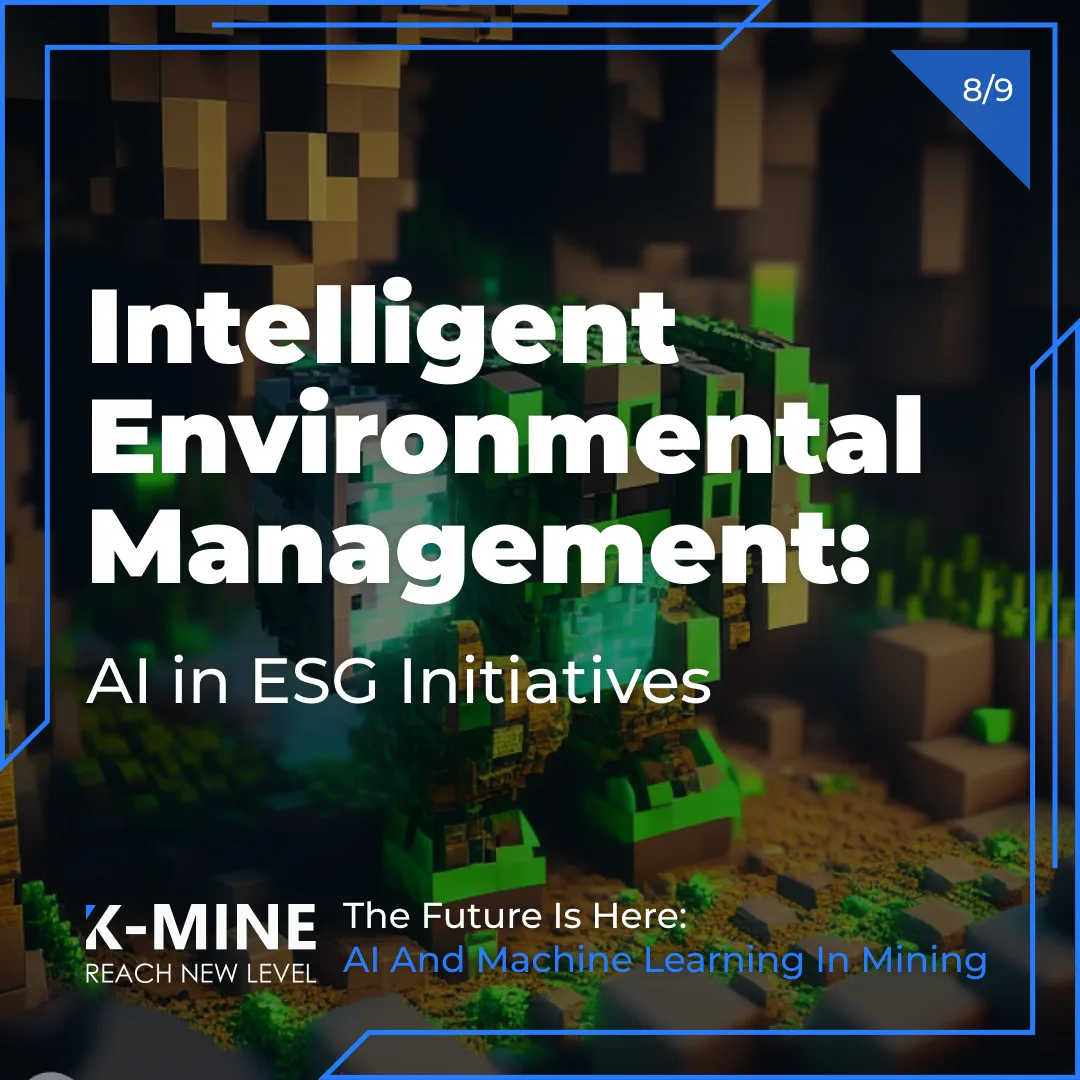
The Future is Here: AI and Machine Learning in Mining. Part 8
Content
In the mining sector, where the stakes are high and the repercussions can last for generations, responsible stewardship is a non-negotiable imperative. Environmental, social, and governance (ESG) initiatives have taken center stage in recent years, driving a new vision for sustainable practices and ethical conduct in an industry historically fraught with challenges. The emphasis on ESG initiatives signals a clear and intentional departure from unsustainable practices, marking a commitment to consider not just economic outcomes, but also the wider societal and environmental impacts.
But, despite the earnestness of these initiatives, the execution and management of ESG efforts in mining can be complex, arduous, and fraught with challenges. However, a new ally in the form of artificial intelligence (AI) has emerged, presenting promising avenues to overcome some of these hurdles. The potent combination of AI and ESG initiatives in mining holds the potential to unlock unprecedented advancements in sustainable mining practices, setting the stage for a more responsible and conscientious industry. As we delve deeper into this topic, we will explore how AI is not only enhancing the effectiveness of ESG initiatives but is also shaping the future of sustainable mining.
Understanding ESG Initiatives in Mining
Environmental, Social, and Governance (ESG) initiatives are a comprehensive set of standards and practices that companies adopt and follow in their operations to promote sustainability and ethical conduct. These initiatives aim to foster a positive impact on society while also delivering sustainable economic performance. In the mining industry, ESG initiatives are particularly crucial given the significant environmental footprint and societal implications of mining activities.
Environmental initiatives in mining might include efforts to reduce emissions and waste, manage water use, rehabilitate mining sites, and safeguard biodiversity. Social initiatives often focus on the welfare of employees and local communities, encompassing aspects such as health and safety, labor rights, community engagement, and fair employment practices. Governance initiatives, on the other hand, address the ethical conduct of a company, its transparency, and its compliance with laws and regulations.
Implementing ESG initiatives in the mining sector, however, comes with a unique set of challenges. The inherently disruptive nature of mining operations makes environmental sustainability a difficult goal. Social initiatives can be complicated by diverse and often competing interests among stakeholders. Governance practices, while often well-intentioned, can struggle with issues of transparency and enforcement.
The effective implementation of ESG initiatives in mining, therefore, requires innovative solutions that can navigate these complexities. As we will explore in the subsequent sections, artificial intelligence is emerging as a powerful tool that can aid and enhance these efforts, potentially revolutionizing ESG practices in the mining industry.
The Advent of AI in ESG Initiatives
As industries globally are progressively turning to artificial intelligence (AI) to enhance operations and decision-making, the mining sector is no exception. AI is beginning to play an instrumental role in driving ESG initiatives within the mining industry.
AI can process vast amounts of data far beyond the capabilities of human analysis. This enables mining companies to gain unprecedented insights into their operations and their environmental and social impacts. Through advanced algorithms and machine learning, AI can identify patterns, generate predictions, and provide solutions that can significantly improve ESG performance.
In the environmental domain, AI can help optimize resource use, reduce waste, and minimize the environmental footprint of mining operations. For example, machine learning algorithms can analyze geological and operational data to optimize mining processes, thereby reducing energy consumption and emissions. Similarly, AI can help in designing and managing waste treatment processes, minimizing the environmental impact.
On the social front, AI can help mining companies better understand and engage with their stakeholders, including employees and local communities. AI can analyze social data to identify community concerns, predict social risks, and support engagement strategies. In terms of worker safety, AI can monitor operational data to predict safety incidents and guide interventions, as we discussed in detail in our previous article on mining safety.
In governance, AI can enhance transparency and compliance. By automating and improving data collection and analysis, AI can help companies track and demonstrate their compliance with regulatory requirements and their progress towards ESG goals.
The application of AI in ESG initiatives in mining is still in the early stages, but the potential is immense. In the next sections, we will delve deeper into how AI is helping predict and manage environmental impacts and the role it can play in revolutionizing ESG practices in the mining sector.
Predicting Environmental Impacts with AI
One of the transformative potentials of AI in ESG initiatives lies in its ability to predict environmental impacts. In mining, where operations can significantly impact the surrounding environment, predicting and mitigating these effects are crucial.
AI can analyze various data types, including geological, meteorological, and operational data, to predict environmental impacts. For instance, machine learning algorithms can be used to forecast air and water quality based on mining activities and weather conditions. This predictive capability can guide companies in their operations to minimize pollution and comply with environmental standards.
Moreover, AI can predict the ecological impacts of mining. Machine learning models can be trained on data about local wildlife and vegetation, coupled with anticipated mining activities, to predict potential effects on biodiversity. Predictions could include changes in wildlife behavior or reductions in certain plant species, allowing companies to develop mitigation strategies before adverse effects occur.
AI’s predictive capabilities also extend to the assessment of potential land degradation. It can predict erosion patterns and the stability of mine waste repositories, facilitating the development of preventive measures.
Additionally, AI can assist in modeling and predicting the outcomes of environmental restoration efforts following mine closure. It can help identify which plant species are most likely to thrive in reclaimed land or which land reclamation techniques are most effective given the local environment and previous mining activities.
In all these applications, the use of AI for environmental prediction helps mining companies transition from a reactive to a proactive stance. It allows for forward-thinking environmental management, optimizing actions to mitigate impacts before they occur and ensuring a sustainable future for both the mining operation and the environment it operates within.
AI in Environmental Management
Artificial Intelligence (AI) is transforming how mining operations manage their environmental impacts, making it a critical component in the realization of ESG initiatives.
To begin with, AI can play an instrumental role in monitoring environmental conditions in real-time. Advanced sensor technologies paired with AI can track key indicators such as air and water quality, noise, vibration, and wildlife movement. AI algorithms can analyze this data, identify patterns, and generate insights into the environmental footprint of mining operations. Real-time monitoring also enables immediate response to any environmental disruptions, ensuring that mitigation measures are implemented effectively and promptly.
Furthermore, as we’ve discussed in the previous section, AI can be a powerful tool for predicting environmental impacts. By leveraging machine learning algorithms, AI can model complex interactions between mining activities and the environment, forecasting potential changes. This predictive ability is crucial for proactive environmental management, enabling mining operations to anticipate impacts and take preventive actions.
Beyond monitoring and prediction, AI also supports the execution of remediation efforts. Machine learning algorithms can analyze historical data to determine the most effective reclamation methods for specific types of land or ecosystems. AI can also be used to optimize the scheduling and allocation of resources for reclamation activities, ensuring the efficient use of resources.
Moreover, AI can facilitate continuous improvement in environmental management practices. Machine learning algorithms can identify trends and correlations from large datasets, providing insights that can be used to enhance strategies. For example, AI might identify certain operational practices that are strongly correlated with environmental impact, allowing for targeted improvements.
In conclusion, AI is a valuable ally in environmental management within the mining sector. It enhances monitoring capabilities, empowers mining companies with predictive abilities, supports the execution of remediation efforts, and fosters continuous improvement in environmental management. AI has the potential to make ESG initiatives in mining more effective, data-driven, and proactive, offering promising avenues for the industry’s sustainability journey.
The Benefits and Challenges of AI in ESG Initiatives
The integration of Artificial Intelligence (AI) into ESG initiatives offers immense benefits for the mining industry. However, it also presents certain challenges that must be acknowledged and addressed to harness its full potential.
One of the most significant advantages of AI is improved accuracy in environmental monitoring and impact prediction. Through the analysis of complex data sets, AI can uncover subtle patterns and correlations that might be missed by traditional methods. This precision enables more accurate forecasting of environmental impacts and better decision-making for environmental management.
Moreover, AI offers enhanced efficiency. Automated data analysis saves considerable time compared to manual methods. It also allows for real-time monitoring and immediate responses to environmental disruptions, further reducing potential damages and the associated costs.
AI also offers scalability. With AI, mining companies can analyze vast amounts of data from multiple sources and locations, facilitating a comprehensive view of their environmental footprint. This is particularly valuable in large-scale mining operations spread over vast geographical areas.
Despite these advantages, the application of AI in ESG initiatives is not without its challenges. One significant concern is data quality. The effectiveness of AI algorithms depends on the quality and volume of data they are fed. Inaccurate, incomplete, or biased data can lead to misleading results, which can potentially harm rather than help environmental management efforts.
Additionally, integrating AI systems with existing processes and technologies can be complex and resource-intensive, requiring considerable investment in time, money, and technical expertise.
Ethical considerations also come into play. With the increased use of AI, issues around data privacy and security become paramount. It’s essential to establish robust data governance frameworks that address these concerns while ensuring compliance with relevant regulations.
In summary, while AI offers significant benefits in advancing ESG initiatives in mining, it also introduces new challenges. A thoughtful, well-planned approach is needed to navigate these issues and fully harness the potential of AI in environmental management. The road ahead might be complex, but the rewards promise to be well worth the journey.
Conclusion
In the exploration of AI’s role in Environmental, Social, and Governance (ESG) initiatives, we’ve uncovered a transformative force capable of reshaping the mining industry’s approach to sustainability. Traditional ESG efforts, while invaluable, have faced considerable challenges, such as the difficulty of accurately predicting environmental impacts and efficiently monitoring vast mining operations. These challenges have often led to reactive measures, where issues are addressed post-occurrence rather than prevented proactively.
Enter Artificial Intelligence. With its capability to analyze vast amounts of data with high precision and speed, AI provides a powerful tool for predicting environmental impacts, monitoring conditions in real-time, and facilitating effective management strategies.
Through predictive modeling, AI can anticipate environmental disruptions before they happen, allowing for proactive measures that can significantly reduce the potential impact on the environment. In addition, real-time monitoring enabled by AI can catch disruptions as they occur, facilitating immediate response and minimizing potential damage.
AI is also playing a crucial role in managing environmental effects. It aids in designing remediation strategies and even in monitoring their effectiveness, ensuring that the environmental footprint of mining operations is kept to a minimum.
Yet, as we have seen, the journey towards AI integration is not without its hurdles. Data quality, system integration, and ethical considerations pose significant challenges. These are serious concerns that need to be addressed if we are to make full use of AI’s potential in ESG initiatives.
As we conclude this series on AI in mining, it’s clear that this technology offers remarkable opportunities for the industry. From safety to productivity, and now to sustainability, AI is a game-changer, heralding a new era for mining where efficiency, safety, and environmental responsibility go hand in hand. As we forge ahead, it’s an exciting journey of transformation that lies before us, one that promises to redefine the very essence of mining in the years to come.



 Back
Back